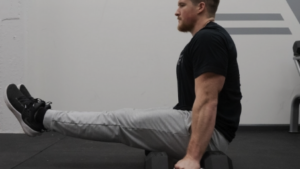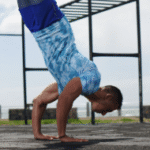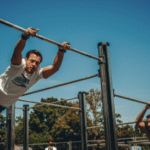L-Sit: Core Strength & Stability Mastery
The L-sit is a challenging bodyweight exercise that requires significant core strength, stability, and control. It involves lifting your legs off the ground while supporting your body weight on your hands, creating an “L” shape with your body. This exercise is a fantastic way to develop core strength, improve shoulder stability, and enhance overall body control.
Key Muscle Groups Involved:
Abdominals: The rectus abdominis, transverse abdominis, and obliques work together to keep the torso rigid and prevent any sagging or rounding of the back.
Hip Flexors: The hip flexors are responsible for lifting and holding the legs in the L-sit position. Strong hip flexors are crucial for maintaining the proper form and preventing the legs from dropping.
ps and Shoulders: The triceps and shoulder muscles work together to support the body weight and maintain straight arms throughout the exercise.
Forearms and Grip: A strong grip is essential for maintaining a secure hold on the supporting surface, whether it’s the floor, parallettes, or dip bars.
Technique:
Starting Position: Begin by sitting on the floor with your legs extended in front of you and your hands shoulder-width apart on the floor, parallettes, or dip bars. Your fingers should be pointing forward.
Lift: Engage your core and press down through your hands, lifting your body off the ground. Simultaneously, lift your legs until they are parallel to the floor, forming an “L” shape with your body.
Hold: Maintain a straight line from your head to your toes, keeping your core engaged and your back straight. Hold the position for as long as possible while maintaining proper form.
Lower: Slowly lower your legs back to the ground, maintaining control throughout the movement.
Benefits:
Increased Core Strength: The L-sit is a highly effective exercise for developing core strength and stability.
Improved Shoulder Stability: It strengthens the shoulder muscles and improves shoulder stability, which is crucial for various other exercises and movements.
Enhanced Body Control: The L-sit requires significant body control and coordination, leading to improved overall body awareness.
Increased Hip Flexibility: It helps to improve hip flexor flexibility, which can be beneficial for various activities and movements.
Progressions:
Tuck L-Sit: Begin by performing the L-sit with your knees bent and tucked towards your chest.
One Leg Extended L-Sit: Extend one leg out while keeping the other leg tucked. Alternate legs to build strength and balance.
Straddle L-Sit: Extend both legs out to the sides in a straddle position.
Full L-Sit: Achieve the full L-sit position with both legs extended and together.
Tips:
Start with proper progressions: Don’t attempt the full L-sit until you have mastered the necessary progressions.
Focus on form: Maintain a straight line from head to toe and avoid sagging or rounding your back.
Engage your core: Keep your core tight throughout the movement.
Practice regularly: Consistent practice is key to mastering the L-sit.
Listen to your body: Rest when needed and avoid overtraining.
The L-sit is a challenging but rewarding exercise that can significantly improve your core strength, stability, and body control. With dedication and consistent effort, you can master this impressive feat of bodyweight training.

L-Sit: Core Strength & Stability Mastery
Route
Calisthenics Gym Houston Functional Bodyweight Training
Secondary phone: (346) 483-3195
Email: info@calisthenicsclubhouston.com
URL: https://calisthenicsclubhouston.com/
Monday 6:00 AM - 7:00 PM Tuesday 6:00 AM - 7:00 PM Wednesday 6:00 AM - 7:00 PM Thursday 6:00 AM - 7:00 PM Friday 12:00 PM - 6:30 PM Saturday 9:45 AM - 12:00 PM Sunday 3:00 PM - 5:00 PM





